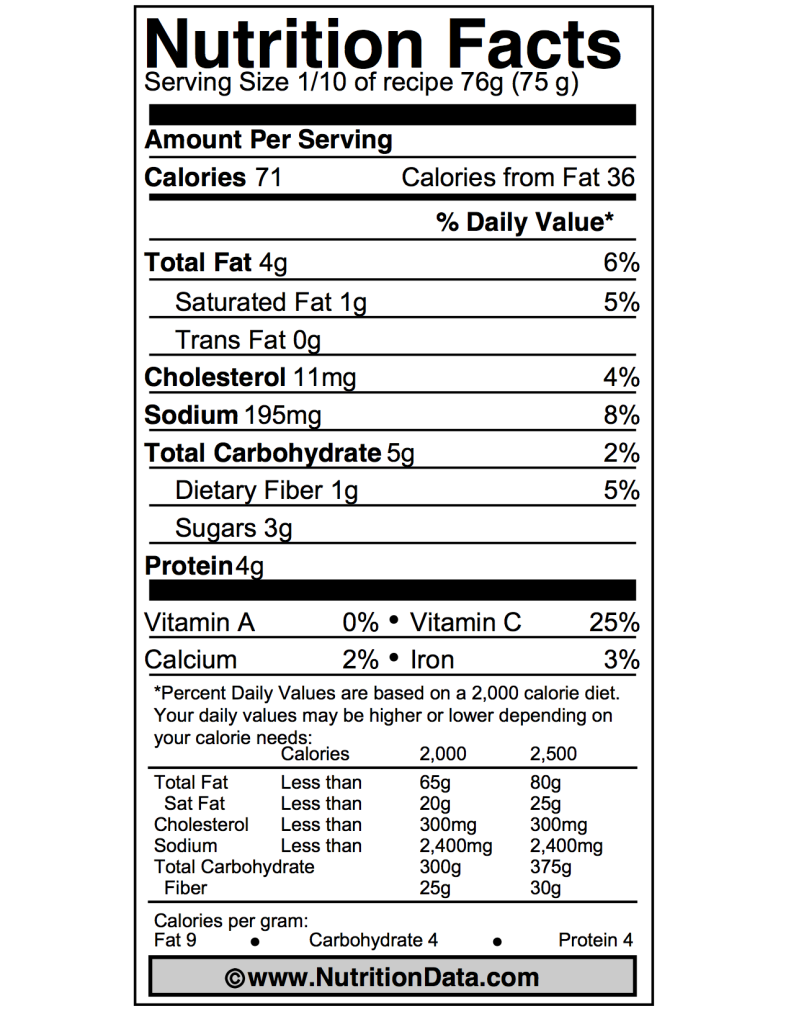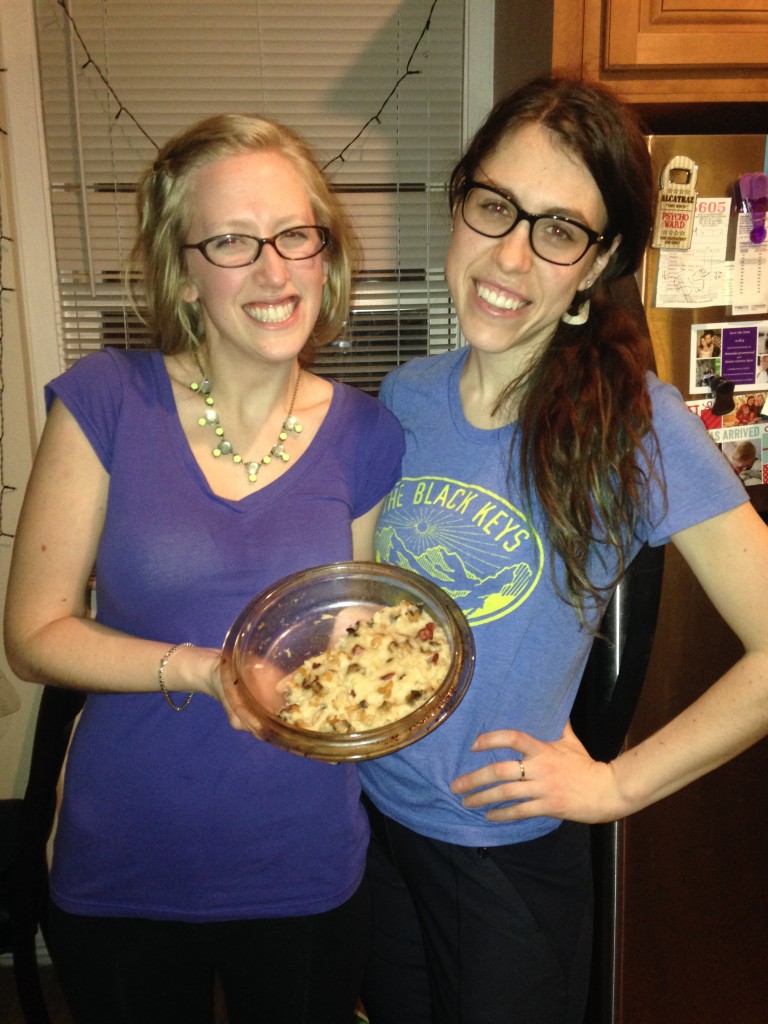Registered Dietitian Emily Bostrom sat down again with her cousin, Alyssa Kurtzman, to talk nutrition while they tried their hand at making Chinese daikon cakes.
Alyssa: Just to give a little background on this particular project, we used to live near Chinatown, specifically near a Chinese deli that sold something called daikon cakes. They’re square, white, starchy, and kind of have the consistency of a gummy bear, if a gummy bear were savory and had chunks of Chinese sausage in it. We also discovered them to be the Best. Hangover. Remedy. Ever.
Recently, we found this recipe in The Hairpin and decided to try it (and document it) while I ask Emily some of the many food-related questions that pop into my head on a daily basis. All ingredients were purchased at an Asian supermarket in Manhattan’s Chinatown. Since it happens to be Oscar night, we’re also judge-watching the red carpet show.
To start, Emily is grating the daikon radish, while Alyssa soaks the mushrooms with some teeny dried shrimp before chopping ensues.
Emily also smartly brought some chewy ginger candy, which is gluing our mouths shut and thus preventing us from eating all this deliciously peppery daikon raw.
We throw the grated daikon into a pot of boiling water to let it cook for about 15 minutes. While that happens, we chop up some Chinese sausages and throw them in a hot skillet with about a tablespoon of oil. After a few minutes, we pick out the big pieces and eat them because, yea. Then we toss in the soaked mushrooms and shrimp. Smells great so far.

Grated Daikon
Time for Question 1:
QUESTION 1: WTF is so wrong about carbs, anyway?
Emily: Oh, carbohydrates. The big scary monster in the pantry. We love you carbs!!! But we hate you! It’s all very complicated. Carbohydrate intake is a super polarizing topic in the nutrition world, so right off the bat I will say that I am a relatively “moderate, middle of the road” Registered Dietitian (RD) who relies heavily on evidence when making nutrition recommendations. I also recognize that depending on the client’s health history, all of this information could change. There are health conditions (they are pretty rare… if you had one you would know) which are best treated by an almost entirely carbohydrate free diet. However, for the general, healthy, active US population, I think carbohydrates are great in moderation (boring, I know). People tend to think carbohydrates are evil because a diet really rich in carbohydrates tends to (1) leave you feeling hungry an hour after a large meal, (2) make you feel sluggish after said meal, (3) prevent your body from utilizing any stored fat, and (4) sometimes storing more energy as fat, depending on your daily calorie intake. A serving size of cooked carbohydrates is only ½ cup. Compared to what we are used to eating, that is tiny. So, no need to avoid carbohydrates, but try to be cautious about how much you’re putting on your plate.
The best sources of carbohydrates in your diet are fruit, vegetables, dairy, and whole grains. Allowing as few “simple carbohydrates” as possible is really the best. This means pick brown rice instead of white, sweet potatoes over white, and try to lean toward whole wheat, grainy breads.
Alyssa: Which are way more delicious, anyway.
Once the mushrooms, shrimp, and sausage have cooked for a while, we add the cooked and drained (with liquid reserved) daikon, and mix the whole thing together before it cooks for about 10 minutes. Then, we dump it all into a mixing bowl, add a little of the reserved daikon-cooking water, throw in about a cup of rice flour (which looks so much like powdered sugar that Alyssa needs to keep it in a separate cabinet), and stir until it’s all kind of sticky.
Emily: This kind of looks like we’re making latkes! Like as if we’re making latkes with glue.
Alyssa: Mmmmmmm…?
Then, it’s steamy time.
We pour this weird gelatinous mix into a glass dish, which we carefully lower into a “steamer” that we jerry-rigged using a stockpot and an overturned mug. Right now, it looks kind of like a pot filled with white vomit.
Now, it has to steam for an hour, most of which is spent talking about the following topic:
QUESTION 2: Should I be using coconut oil? It seems to be all the rage.
Emily: That’s a really good question. The answer is, we don’t really know yet. With the rise in popularity of the “Paleo Diet,” it sure is a hot item these days: it’s one of the few oils—along with olive and canola oil—that are allowed on that diet. Coconut oil is quite high in saturated fat, but also high in lauric acid, which is a medium chain tryglyceride (MCT), which is why people think it might be good for you. Studies have shown that coconut oil might have a beneficial effect on your healthy cholesterol, but these studies are very limited, and include both human and animal populations. MCT oil in general, has been shown to raise both your healthy cholesterol (HDL) and your unhealthy cholesterol (LDL) levels. Since the jury is still out on this, the general recommendation is to use coconut oil only in moderation, since it is still a source of saturated fat. Overall, you should stay away from partially hydrogenated coconut oil.
Refined coconut oil is good for cooking at high temperatures, since it has a high smoking temperature, but if using “virgin” coconut oil, it’s best for baking and medium heat sautéing. I WILL say coconut oil makes a delightful hair mask. But don’t rub it into your roots. Trust me.
(Read here for more information)
Next, we have some fun typing the ingredients into nutritiondata.self.com to figure out the nutritional content of a daikon cake.
(Emily: The label says it’s for 1/10 of the whole thing; it’s really more like 1/12.)

By this point, we’re running out of ginger chews and getting ready to taste this concoction, which after an hour looks like… solidified white vomit. Yum. Time for the big taste test….

Cake Post-Steaming
And the consensus is: delicious! Shockingly close to the cakes we used to buy in Chinatown! We don’t bother to cut ours up into individual wedges, though, because—duh—we’re family. And although ours is much lumpier than the three-for-$1.50 ones we used to binge on after long nights of drinking, the consistency is almost the same. It’s as if the daikon and shrimp melted into the rice flour and water. And the chunks of mushroom and sausage are like little umami explosions. If we were Olympic judges, we would give it a 7.5 for taste and maybe a -5 for appearance.
So, we tuck into our successful little dish, with some rice vinegar for dipping, while Emily addresses one final question:
QUESTION 3: Last week, right before she danced with some vegetables, Michelle Obama apparently said some stuff about new food labels. What’s all the fuss about?
Emily: Oh, Mrs. First Lady, RD’s everywhere were singing your praises last week. Thank goodness for all the awareness she is raising for nutrition’s role in health and well being! I have one giant, fruit-and-veggie-driven girl crush on Michelle Obama. Also, on her arms. So good.
Alyssa: So sculpted.
Emily: She would be Oscar gown ready at any moment. Anywho, she announced that nutrition fact labels will be changing soon, for the first time in almost 20 years. This is big! And here are some of the major changes to be expected:
Serving sizes: Instead of a serving of, say, ice cream, being listed as 1/2 cup (has anyone in history ever eaten a measly 1/2 cup of ice cream?!), they have decided to make a “serving” on the container listed as a much more likely 1 cup. This way, instead of glancing at the label and seeing that the ice cream has only 150 calories per serving, you’ll see 300 and realize what you are actually going to eat. I approve!
No more calories from fat: The current food label was written in the fat-fearful 1990’s, which is why there is that strange, seemingly useless “calories from fat” label is right at the top. Now that we love (healthy sources of) fat, evidence is showing that we shouldn’t really care about “calories from fat” and should instead focus more on…
Added Sugars: Hallelujah! I am so excited to have this addition to our food label (I’m realizing as I write this that I’m likely more excited than most people). When counseling and educating clients, I am always speaking about the difference between “naturally occurring sugars” and “added sugars.” But, it’s still confusing when all of the sugars on the food label are under just one heading! Now, when you pick up that yogurt, you will see the “total sugars” listed as 21g, and “added sugars” as 13g. This will be so helpful for people looking to avoid too many added sugars, but who understand that the lactose in that yogurt is not what they’re trying to avoid. Things like 100% fruit juice will still have no added sugar listed, but things like fruit purees (applesauce, preserves, jelly) will tell you exactly how much of that sugar on the label will be from the super healthy fruit, and how much will be from sugar, agave, high fructose corn syrup, evaporated cane syrup, honey, etc. I must say, this is a good time to be a Dietitian.
About a third of the way through the daikon cake, we remember to take a photo.
Just in time to start watching the Oscar ceremony! Come on, guy from Captain Phillips!
Until next time…
Emily Bostrom, RD, is a Registered Dietitian with degrees from Rutgers University and the University of Medicine and Dentistry of New Jersey, who eats, cooks and thinks about food. You can also find her singing loudly in the car and at http://www.emilybostrom.
Alyssa Kurtzman is a Content Manager at @CLIPTAMATIC and works on the UE social media staff. Life mantra: It’s never too hot for soup. @KURTZMANIA




